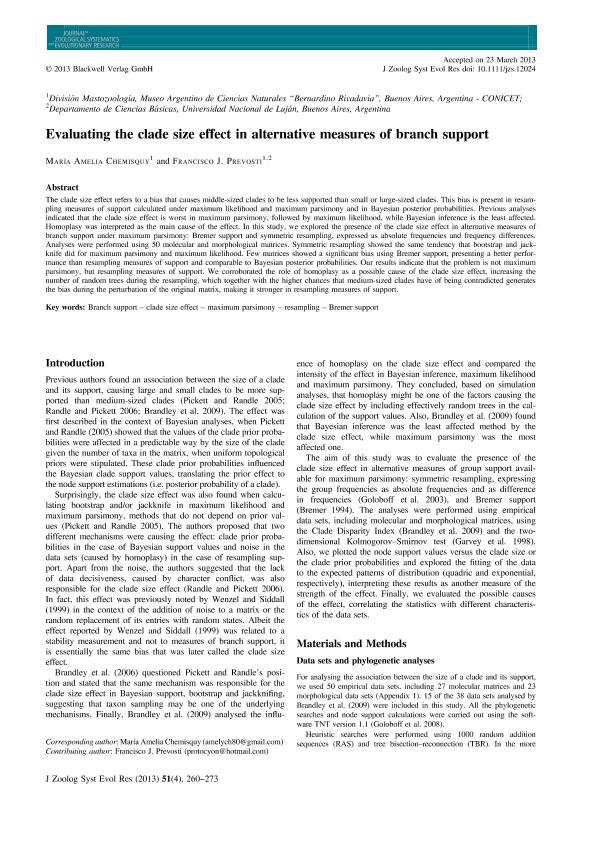Mostrar el registro sencillo del ítem
dc.contributor.author
Chemisquy, Maria Amelia

dc.contributor.author
Prevosti, Francisco Juan

dc.date.available
2016-02-11T15:49:52Z
dc.date.issued
2013-11
dc.identifier.citation
Chemisquy, Maria Amelia; Prevosti, Francisco Juan; Evaluating the clade size effect in alternative measures of branch support; Wiley; Journal of Zoological Systematics and Evolutionary Research; 51; 4; 11-2013; 260-273
dc.identifier.issn
0947-5745
dc.identifier.uri
http://hdl.handle.net/11336/4144
dc.description.abstract
The clade size effect refers to a bias that causes middle-sized clades to be less supported than small or large-sized clades. This bias is present in resampling measures of support calculated under maximum likelihood and maximum parsimony and in Bayesian posterior probabilities. Previous analyses indicated that the clade size effect is worst in maximum parsimony, followed by maximum likelihood, while Bayesian inference is the least affected. Homoplasy was interpreted as the main cause of the effect. In this study, we explored the presence of the clade size effect in alternative measures of branch support under maximum parsimony: Bremer support and symmetric resampling, expressed as absolute frequencies and frequency differences. Analyses were performed using 50 molecular and morphological matrices. Symmetric resampling showed the same tendency that bootstrap and jackknife did for maximum parsimony and maximum likelihood. Few matrices showed a signicant bias using Bremer support, presenting a better performance than resampling measures of support and comparable to Bayesian posterior probabilities. Our results indicate that the problem is not maximum parsimony, but resampling measures of support. We corroborated the role of homoplasy as a possible cause of the clade size effect, increasing the number of random trees during the resampling, which together with the higher chances that medium-sized clades have of being contradicted generates the bias during the perturbation of the original matrix, making it stronger in resampling measures of support.
dc.format
application/pdf
dc.language.iso
eng
dc.publisher
Wiley

dc.rights
info:eu-repo/semantics/openAccess
dc.rights.uri
https://creativecommons.org/licenses/by-nc-sa/2.5/ar/
dc.subject
Branch Support
dc.subject
Clade Size Effect
dc.subject
Maximum Parsimony
dc.subject
Resampling
dc.subject
Bremer Support
dc.subject.classification
Biología

dc.subject.classification
Ciencias Biológicas

dc.subject.classification
CIENCIAS NATURALES Y EXACTAS

dc.title
Evaluating the clade size effect in alternative measures of branch support
dc.type
info:eu-repo/semantics/article
dc.type
info:ar-repo/semantics/artículo
dc.type
info:eu-repo/semantics/publishedVersion
dc.date.updated
2016-03-30 10:35:44.97925-03
dc.journal.volume
51
dc.journal.number
4
dc.journal.pagination
260-273
dc.journal.pais
Estados Unidos

dc.journal.ciudad
Hoboken
dc.description.fil
Fil: Chemisquy, Maria Amelia. Consejo Nacional de Investigaciones Científicas y Técnicas. Oficina de Coordinación Administrativa Parque Centenario. Museo Argentino de Ciencias Naturales; Argentina
dc.description.fil
Fil: Prevosti, Francisco Juan. Consejo Nacional de Investigaciones Científicas y Técnicas. Oficina de Coordinación Administrativa Parque Centenario. Museo Argentino de Ciencias Naturales; Argentina. Universidad Nacional de Luján. Departamento de Ciencias Básicas; Argentina
dc.journal.title
Journal of Zoological Systematics and Evolutionary Research

dc.relation.alternativeid
info:eu-repo/semantics/altIdentifier/doi/http://dx.doi.org/10.1111/jzs.12024
dc.relation.alternativeid
info:eu-repo/semantics/altIdentifier/url/http://onlinelibrary.wiley.com/doi/10.1111/jzs.12024/abstract
dc.relation.alternativeid
info:eu-repo/semantics/altIdentifier/issn/0947-5745
Archivos asociados
